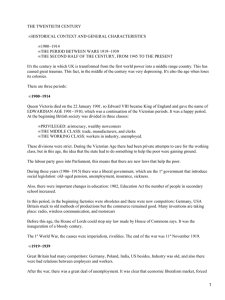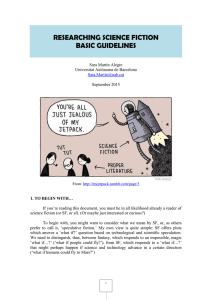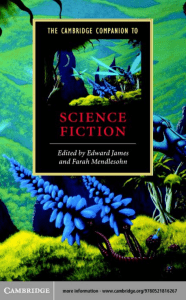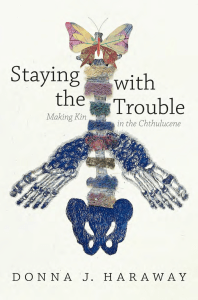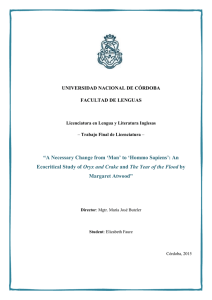Tom Idema Utrecht University, the Netherlands Adam Trexler
Anuncio
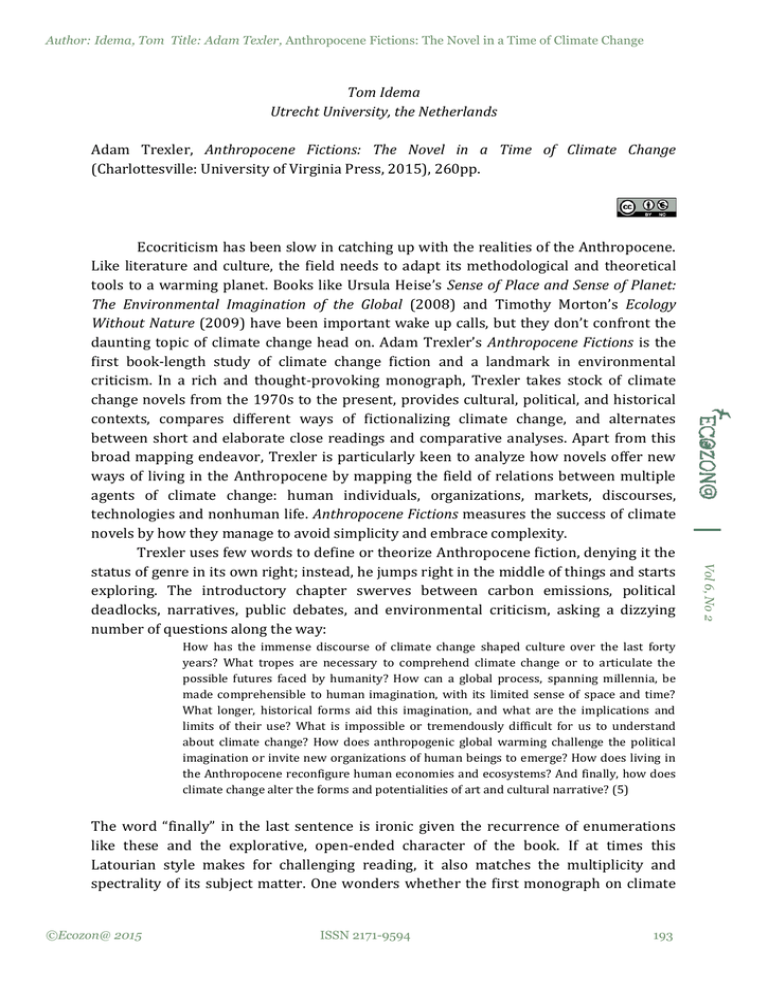
Author: Idema, Tom Title: Adam Texler, Anthropocene Fictions: The Novel in a Time of Climate Change Tom Idema Utrecht University, the Netherlands Adam Trexler, Anthropocene Fictions: The Novel in a Time of Climate Change (Charlottesville: University of Virginia Press, 2015), 260pp. How has the immense discourse of climate change shaped culture over the last forty years? What tropes are necessary to comprehend climate change or to articulate the possible futures faced by humanity? How can a global process, spanning millennia, be made comprehensible to human imagination, with its limited sense of space and time? What longer, historical forms aid this imagination, and what are the implications and limits of their use? What is impossible or tremendously difficult for us to understand about climate change? How does anthropogenic global warming challenge the political imagination or invite new organizations of human beings to emerge? How does living in the Anthropocene reconfigure human economies and ecosystems? And finally, how does climate change alter the forms and potentialities of art and cultural narrative? (5) The word “finally” in the last sentence is ironic given the recurrence of enumerations like these and the explorative, open-ended character of the book. If at times this Latourian style makes for challenging reading, it also matches the multiplicity and spectrality of its subject matter. One wonders whether the first monograph on climate ©Ecozon@ 2015 ISSN 2171-9594 193 Vol 6, No 2 Ecocriticism has been slow in catching up with the realities of the Anthropocene. Like literature and culture, the field needs to adapt its methodological and theoretical tools to a warming planet. Books like Ursula Heise’s Sense of Place and Sense of Planet: The Environmental Imagination of the Global (2008) and Timothy Morton’s Ecology Without Nature (2009) have been important wake up calls, but they don’t confront the daunting topic of climate change head on. Adam Trexler’s Anthropocene Fictions is the first book-length study of climate change fiction and a landmark in environmental criticism. In a rich and thought-provoking monograph, Trexler takes stock of climate change novels from the 1970s to the present, provides cultural, political, and historical contexts, compares different ways of fictionalizing climate change, and alternates between short and elaborate close readings and comparative analyses. Apart from this broad mapping endeavor, Trexler is particularly keen to analyze how novels offer new ways of living in the Anthropocene by mapping the field of relations between multiple agents of climate change: human individuals, organizations, markets, discourses, technologies and nonhuman life. Anthropocene Fictions measures the success of climate novels by how they manage to avoid simplicity and embrace complexity. Trexler uses few words to define or theorize Anthropocene fiction, denying it the status of genre in its own right; instead, he jumps right in the middle of things and starts exploring. The introductory chapter swerves between carbon emissions, political deadlocks, narratives, public debates, and environmental criticism, asking a dizzying number of questions along the way: Author: Idema, Tom Title: Adam Texler, Anthropocene Fictions: The Novel in a Time of Climate Change ©Ecozon@ 2015 ISSN 2171-9594 194 Vol 6, No 2 change fiction can be anything but dazzling, and whether enlistment―involving a multiplicity of people, things, events, and questions―is not a key strategy for any analysis (or aesthetics) of climate change. Anthropocene Fictions is divided in four bulky chapters organized around the themes of truth (notably the relation between literature and science), place (the continuing imaginative power of cultural myths, deluge narratives in particular), politics (the role of states and environmental organizations) and economics (capitalism, markets, and environmental justice). Each chapter is invested in critically assessing the narrative strategies of a number of climate novels against the imperatives of urgency and complexity. The pitfalls of climate change fiction, Trexler argues, are often connected to genre conventions. Thriller novels like Clive Cussler’s Arctic Drift and Michael Glass’s Ultimatum tend to reduce the politics of climate change to a disagreement among nation states or between states and environmental organizations. Apocalyptic narratives usually skip climate change altogether, offering a world that has little in common with the present, as in Margaret Atwood’s Oryx and Crake or Cormac McCarthy’s The Road. Techno-optimistic works of science fiction such as Kim Stanley Robinson’s “Science in the Capital” trilogy risk downplaying complexity in a bid for comprehensive solution. Finally, realist narrative tends to revolve around the mundane lives of a very limited set of characters, focusing on their inner worlds, and thereby neglecting institutional and nonhuman actors. Although many of his analyses involve critical assessments of the limitations of contemporary climate fiction, Trexler also takes care to point out literature’s potentialities, including those of generic hybridization. Although Trexler hardly expounds his theoretical position, his study breathes the air of critical posthumanism and speculative realism. The central concern of Anthropocene Fictions is not to see how literature represents climate change, but rather to establish “how climate change and all its things have changed the capacities of recent literature” (13). The assumption behind this provocative question is that climate change refuses to be a neatly circumscribed topic or theme for narrative, because it is a historical, evolutionary and geological event connecting so many ideas, things, times and places. Literature certainly cannot represent the Anthropocene, but it may immerse itself in it, adapting to an emerging future. How do novels become not so much about as of the Anthropocene? In response to this question, Trexler argues that “climate fiction becomes innovative as it incorporates new things into preexisting genres” (234; emphasis in original). In other words, climate fiction’s innovation is primarily a matter of content: in the Anthropocene, literature begins to properly organize narrative around actor networks. To be faithful to complexity and emergence means to be speculative, and Trexler convincingly argues for the extraordinary relevance of speculative fiction (and science fiction in particular), lamenting its underrepresentation in the canon of ecocriticism. No other genre has been more successful in merging the nonhuman things of climate change with the familiar humanistic stuff of fiction. After a fascinating reading of Paulo Bacigalupi’s The Windup Girl, Trexler concludes that fiction can “conceptualize complex, heterogeneous systems: how national pride, bioengineering, aesthetics, familial love, Author: Idema, Tom Title: Adam Texler, Anthropocene Fictions: The Novel in a Time of Climate Change ©Ecozon@ 2015 ISSN 2171-9594 195 Vol 6, No 2 social resistance, species loss, job loss, local food and flooding might combine to create a way of life in the future” (220). For Trexler, speculative fiction tells us more about our current predicament than most realistic novels, “reflecting contemporary dilemmas between global trade and environmental regulation, altruism and self-interest, technology and reversion” (211), while realistic novels tend to be overinvested in the human psyche, thus failing to explore the world of climate change. In the conclusion, Trexler asks whether a realist fiction of climate change is starting to emerge now that climate change is steadily transforming “from something that ought not to exist to something that already does” (233). If one would extrapolate from Texler’s argument, this new climate change realism would be a speculative realism. One notably strong aspect of the book is its weaving together of literature and science, and its insistence on “the instability of both science and the literary in the face of climate change” (46). Trexler argues that, too often, climate change novels and literary criticism alike reify a blunt distinction between fact and fancy. Countering this stance, Trexler demonstrates that literary texts are vital for understanding climate change, breaking down the image of science as a master discourse. Trexler usefully shows that while this approach is particularly suited to speculative fiction, it can also be applied against the grain to mainstream literary realism. He convincingly demonstrates that whereas Ian McEwan’s Solar and Michael Crichton’s State of Fear are “polemically invested in a realist view of science,” they actually emplot a multitude of actors, including “instruments, colleagues, alliances, and publics,” so that de facto “the novels’ contentions are overrun by the literary possibilities of constructing science, fabricating fiction” (62). Trexler’s onto-political approach is highly welcome next to more humanistic analyses that take climate change novels primarily as cultural expressions of public hopes and fears or as exercises in psychological and ethical struggle. Anthropocene Fictions is a refreshing, exploratory book, faithful to its objective of to serve as “a provocation to further research” (234). It is unapologetically bold in its tone and assertions, for example in the rejection of ecocriticism’s literary canon, and in the claim that fiction tout court is slowly turning into climate change fiction. Although Trexler occasionally draws from scholars such as Ursula Heise, Lawrence Buell, Timothy Clark, and Robert Markley, his study is more of an exploration in Latour-inspired environmental criticism than a critical engagement with the existing scholarship in ecocriticism. Its main ambition, reflected in the subtitle, is to analyze the specific ways in which climate change affects “the capacities of the novel” (15). This goal is somewhat thwarted by the sparse engagement with literary scholarship. Nevertheless, in combining extensive knowledge of environmental criticism, science, politics and culture with insightful and original literary analysis, Trexler’s study greatly contributes to Environmental Humanities research. Moreover, the book’s reliance on science studies arguably makes it more accessible and useful to social and natural scientists as well as to non-academic publics. Such bridge-building is vital if ecocriticism wishes to be a worthy participant in the unfolding story of climate change.

